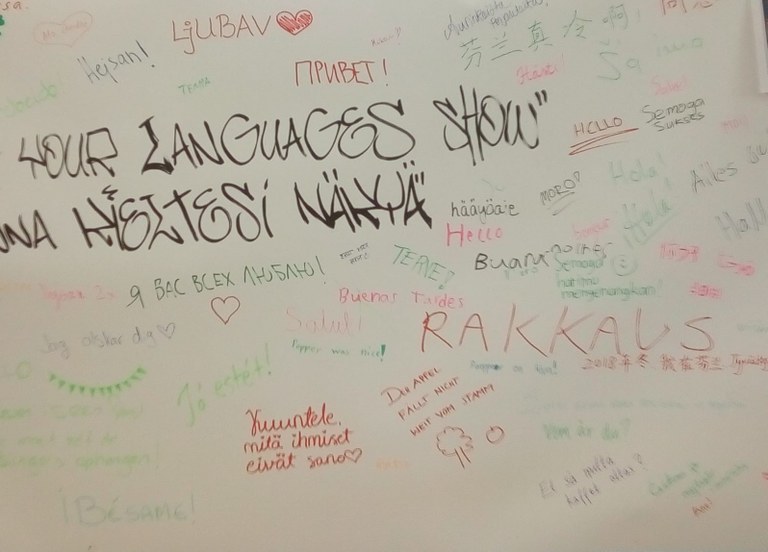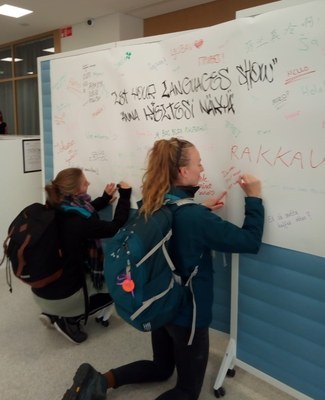Secret languages and self-expression by the Graffiti wall on Researchers' Night 28.9.2018
Published: 18.10.2018 | Text and photos: Rukhsana Ali
Oscar Wilde once stated that, “thought and language are to the artist instruments of an art”. This reflects the feeling experienced at the Researchers’ Night Graffiti wall event, which a free expression was allowing visitors to think, reflect, incite or excite themselves towards using first language in a different social settings. A language, which is breathing with an individual, is a medium of designing the art using emotions and strong feelings. Such an event illustrates that communication with outside world travels from strong words into poetic medium, to become a bigger narration creating prose and shaping pictorial image or any medium of art. We experienced creative calligraphic art and secret or hidden language of emotions into unique blend. Graffiti wall was a previous reviving idea to continue and engage visitors of every age or group to express or reveal what comes to their mind when thinking in their first language. However, enquiring and motivating people to their immediate first language need some instrumental questionings, to dig up their conscious memories, but people felt reluctant or bit hesitant.
The Language Campus activity by putting up a broad board with calligraphic inscriptions was an open invitation to the visitors. The eye-catching inscriptions created multimodal sideshow, which transformed into social interaction with the visitors. After greeting visitors, we introduced the purpose of our activity and asked them to participate by writing something in their first language. In order to facilitate the literacy event we also asked reflective questions such as what comes to your mind when you think of shifting to your mother tongue usage. Do you have any strong feelings and emotion attached to your first language? Thus, visitors paused to have space for reflection on these questions. However, some were still uncertain what to write, while others were shy. However, I tried to support them utilizing moral encouragement. This helped them produce ideas to write and express. Additionally, I tried to motivate through writing my own self-expression in three languages, which was Urdu, Arabic and Persian and my mother tongue Sindhi. One of the Japanese friends wrote about ‘love is peace’, the other student wrote about ‘the home is where the heart is’. Some exchange students from Bosnia felt reluctant to express in their first language. On my query to those students, they reflected the political suppression and lacking confidence due to the political turmoil in their country. Another unique response came up from Quechua language speakers, it sounded different and further discussion took place about it as how it developed through different phases.
An amazing story came up from the visitor about Quechua language, as how it got its status from its hotly disputed origin. According to the scholars, this language originated on the central coast of Peru around 2, 600 BC and spread with the expansion of Inca Empire. It is used, largely as an oral language having a status of an official language in Peru and Bolivia along with Spanish and Aymara.

Another interesting literacy event occurred when a participant wrote in a secret language. A secret code language epitomised the secret opinions, truthful expression, mockery into a strange two language mixing codes surprised all of us. An individual created the di-code secret language at the age of eight. The di-code language became a medium of hidden personal truths about the world. The language font mainly Finnish and English became a transformation into a new language of her own, to identify sounds and words whenever it needed to express innermost feelings. Those secrets were opinion about other class fellows, students of her age and into her immediate contact. Sometimes, home and family affairs remained a hidden expression whenever responses were not given to siblings. The intense feelings were sometimes, fears, credibility of praise to others, exaggeration to other friends and even mockery.
Children followed with other forms of social literacy practices, the Graffiti sheet pasted on the floor attracted kids of every age. Children reached to the task and started scribbling with colours, drawing pictures, and writing few letters and some words. The depiction of such reflections, reveal us the idea of development of art as a form of communicative practices, which seemingly develop through practice and skills, but at times, it is oozing out talent. Some children were too excited to scribble whatever they knew, their parents accompanying them guided them to write some specific texts, which they might have learnt before.


Children’s drawing is a social literacy practice, which they enjoy by using colours (bright, light, dull, vibrant) and depicting their likes into shapes, scribbling on papers that reflect an intelligent view of learner’s mind. This practice reveal mental operations and capacities of children as how they transfer their physical world into meaning. Scientific observation of drawings is quite meaningful, and interesting to understand the behaviour and knowledge construction happening on children minds. One may think deeply as the reason, logic behind the practices of certain depicted drawings drawn up by the children at different age levels. Such drawings and forms of art is one of the way and ‘Style of thinking’ in the graphic activity children show as stated by the scholar Mary Douglas (1996).
Language is a component of identity, through it one feels a sense of ownership and pride in their individual multimodal expression. If not only expression of inside heart but a universe as a whole developed on the minds of a learner. Language resides in the minds of users which society create a picture to it. Language is a socio-cultural practice which resides as a whole set of mechanism within the society and as the individual and community shapes ones’ mind and perspective to see the world through that lens. International students, speaking different native languages, having different identities, class, culture, religion or having different ethnic background relate themselves to the existing culture within the institution using a relational language.
To elucidate the point of mother tongue, or language expression , I cite the sociolinguist Kloss’s useful distinction of the term, ‘tolerance-oriented and promotion-oriented’ language rights. This small activity makes us realise as how one language is over occupied by it’s use and other one is supressed with less effective use. These rights if granted well, may strengthen the rights of individuals to use it at home and in public places, the right to foster the first language in schools is a birth right of every individual. The idea of promotion of any language is a key principle that the state does not ensure but at least social practices and private domains may help to flourish it. The liberty to use first langauge becomes an element of pride, a voice of an individual heard, value of inner feelings, sense of pride leads to minimize the risk of frustration, odd and negative thinking but a free and independent user of lanaguage to safeguard its own self right. My language right and the right of other languages as a human right!
